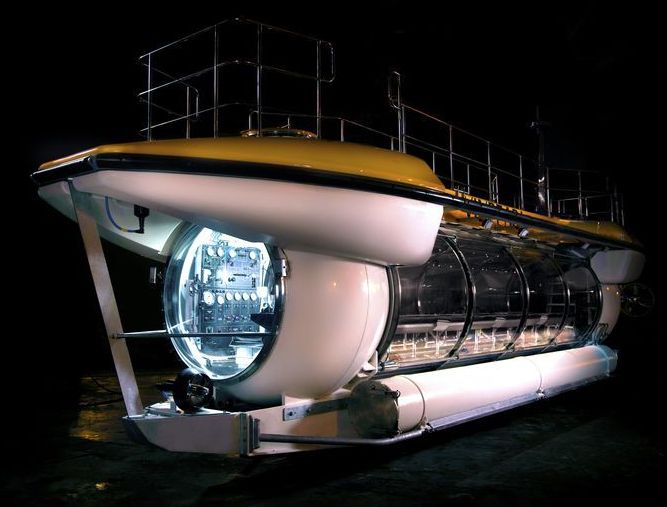Key points Compared to sham rats, rats a week after acute lung injury (ALI) express more proinflammatory cytokines in their brainstem respiratory control nuclei, exhibit a higher respiratory freque…



As the number of confirmed COVID −19 cases worldwide approaches 4 million and the pandemic could be with us for months or years, we look at who can access drugs like remdesivir, being developed by pharmaceutical giant Gilead, which has the patent for the drug and is poised to make massive profits. We look at how much drugs like remdesivir will cost, and who can access them, with writer Achal Prabhala, coordinator of the AccessIBSA project, which campaigns for access to medicines in India, Brazil and South Africa.
This is viewer supported news. Please do your part today.

Triton submarines is the biggest name in deep-sea exploration submersibles, having built the extraordinary DSV Limiting Factor, a “deep-sea elevator” capable of popping down to the bottom of the Mariana Trench several times a week for extended visits.
Now, the company has launched an incredible-looking tourist sub that can take 24 passengers, a pilot and a co-pilot down to 100-meter (328-ft) depths in air-conditioned comfort, providing panoramic views of the aquatic world through colossal 5.5-inch-thick (140-mm) acrylic windows. Where other subs offer restricted views, this thing is very close to a giant transparent tube, like a glass walkway through an aquarium, tall enough to stand in.
The DeepView 24 is the first of a range of DeepView tourist submarines that can be specified in different lengths to accommodate between 12 and 66 passengers. Additional sections can be added six seats at a time; with the 24-seat version already 15.4 m (50.5 ft) in length and weighing 121,250 lb (55,000 kg), a 66-seater would certainly be a sight to behold and a pain in the butt to pull a u-turn in.

The new coronavirus invades the body through a spike protein that lives on the surface of virus cells. The S protein, as it’s called, binds to a receptor called angiotensin-converting enzyme 2 (ACE2) on a healthy cell’s surface. Once attached, the cells fuse and the virus is able to infect the healthy cell.
ACE2 receptors are present on cells in many places throughout the body, and especially in the lungs. Cells in the lungs are also some of the first to encounter the virus, since the primary form of transmission is thought to be breathing in droplets after an infected person has coughed or sneezed.
That’s why it was necessary to upgrade Stem Cell Neurotherapy for COVID-19 by adding T-Cells, B-Cells, and Natural Killer Cells to the arsenal. It was not enough to just regenerate new lung cells to replace the lung cells infected by COVID-19, but the COVID-19 Virus Cells had to be attacked and destroyed in order to prevent them from invading and infecting the newly regenerated lung cells.
So, that’s where the idea of using T-Cells, B-Cells, and Natural Killer Cells, usually used in attacking cancer cells, came from.
Promising results from a very small study caused shares of stem cell stocks to soar, but investors shouldn’t get too carried away just yet.


Few cases and no deaths. I would listen to those who have success, not those who have failure. Scientists from failing countries have warned not to take just about everything to fight this. The WHO’s abysimal performance shows they are the last people anyone should listen to. Show the efficacy of WHO advice, or even ventilators for that matter vs Continuous Positive Airway Pressure (CPAP). If people want to use something to fight this let them, you have the choice of not using it.
Madagascar’s President Andry Rajoelina tries Covid-Organics at a launch ceremony in Antananarivo on 20 April. Several other African leaders have expressed an interest in the unproven treatment.



Leidos subsidiary Dynetics has won a $12.3m valued phase 1 of the Air Combat Evolution (ACE) programme, Technical Area 3 (TA3).
The ACE TA3 (Alpha Mosaic) contract was awarded by the Defense Advanced Research Projects Agency’s (DARPA) Strategic Technology Office (STO).
As an initial challenge scenario, the programme uses aerial dogfighting for implementing artificial intelligence (AI) into high-intensity air conflicts, which increases the soldier’s trust in combat autonomy.

Diagnosing COVID-19 more quickly, easily, and broadly
With COVID-19 rapidly spreading around the planet, the efficient detection of the CoV2 virus is pivotal to isolate infected individuals as early as possible, support them in whatever way possible, and thus prevent the further uncontrolled spread of the disease. Currently, the most-performed tests are detecting snippets of the virus’ genetic material, its RNA, by amplifying them with a technique known as “polymerase chain reaction” (PCR) from nasopharyngeal swabs taken from individuals’ noses and throats.
The tests, however, have severe limitations that stand in the way of effectively deciding whether people in the wider communities are infected or not. Although PCR-based tests can detect the virus’s RNA early on in the disease, test kits are only available for a fraction of people that need to be tested, and they require trained health care workers, specialized laboratory equipment, and significant time to be performed. In addition, health care workers that are carrying out testing are especially prone to being infected by CoV2. To shorten patient-specific and community-wide response times, Wyss Institute researchers are taking different parallel approaches: